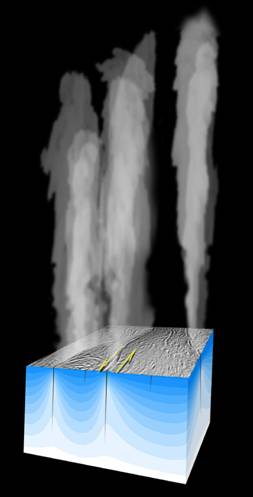18 May 2007

Shear Heating Mechanism
Credit: NASA-JPL
Enceladus is one of the most intriguing moons of Saturn. It is one of only three Solar System objects, apart from Earth, known to show ongoing volcanic activity. The other two objects are Io, Jupiter's third largest moon, and Triton, Neptune's largest moon.
In 2005, the Saturn-bound Cassini spacecraft discovered large plumes of water vapor and other gases, erupting vigorously from the south polar regions of Enceladus. NASA recently published a theory that explains Enceladus' volcanism.
The above figure is an illustration of the "shear heating" mechanism. In this mechanism, tidal forces acting on fault lines in the moon's icy shell cause the sides of the faults to rub back and forth against each other, producing enough heat to transform some of the ice into plumes of water vapor and ice crystals.
Cold sub-surface ice (blue) is heated near the active fractures from which the plumes emanate.
Movement along the fault lines may be about half a meter over the course of the 1.37-day tidal period of Enceladus around Saturn.
Further Reading
Frictional Heating Explains Plumes on Enceladus
http://www.jpl.nasa.gov/news/news.cfm?release=2007-060
Cassini-Huygens Mission
http://saturn.jpl.nasa.gov/home/index.cfm
Enceladus
http://saturn.jpl.nasa.gov/science/moons/moonDetails.cfm?pageID=5
Aymen Mohamed Ibrahem
Senior Astronomy Specialist